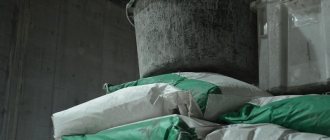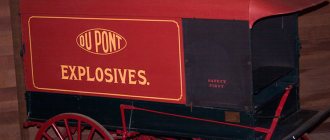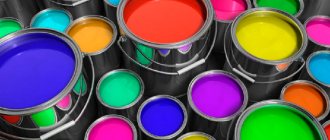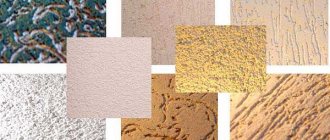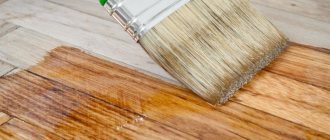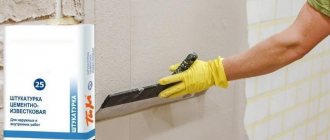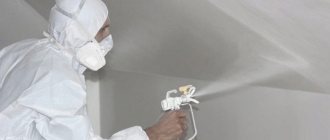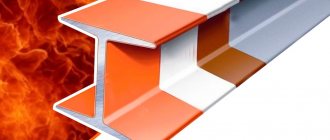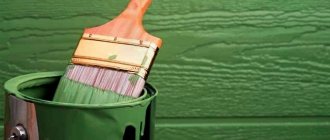Varnishes and coloring compositions in the form of aerosols are used for repairing, decorating, and painting automobile and household appliances, roofs, doors, and interior elements. The quality of work depends on knowing the rules: what tool to choose for painting, what needs to be prepared, how long can paint from a spray can dry, whether a protective coating is necessary. Having collected the information, you can begin restoration or repair.
Aerosols are used for repairs.
Lada 21099 No show-off › Logbook › Spray painting the wings, but wisely.
Car painting from a spray can.
And then rotten tomatoes start flying at me... Why can’t you paint a car from a can? I considered this topic for a very long time, asked the question “why it’s not worth it” and in response I received phrases like “you just can’t”, “this paint is not intended for full painting”, “the paint in the cans is dirty”, “you’ll make a lot of smudges” and “there will be stains are visible." If you start to understand these disadvantages, then they can be simply broken down into two points: - first, stripes will be visible and there will be smudges. I started to figure it out, try it, and it turned out that everything depended only on the skill and “sense of the painter” about the thickness of the applied layer; - second, what can you talk about when there is not a single argument but only a subjective opinion. Agree, a subjective opinion cannot be a weighty argument or argument. To begin with, I found out that the cylinders are filled with ALKYD paint, not acrylic. Elementary, we take the cylinder and read, do not pay attention to the inscriptions present (it happens on some) “reinforced with acrylates.” The paint is alkyd and its behavior on the surface will correspond to the conditions of alkyd paint. Like this? Now I'll try to clarify.
The main disadvantage of alkyd paint is the polymerization time, i.e. the time of its partial and complete drying. In relation to the car, if the acrylic one already dries on the second day and after a week you can safely press a polishing wheel to the surface, then the alkyd one will dry much longer, and it will be possible to polish in at least four weeks, or even longer. The drying time of alkyd paint depends on the ambient temperature, room ventilation and air humidity. The principle of drying alkyd paint is very complex and it dictates its own nuances. When applying paint to the surface, initial drying occurs due to the evaporation of the solvent in the paint, where the outer layer forms a kind of crust, blocking the normal access of oxygen to the paint applied in deeper layers. And uneven drying begins. Those. the outer layer has set into a crust and has already begun to harden a little, but the inner layer remains not dry. Minus? Yes, depending on how you look at it. In terms of complete drying of paintwork, there is undoubtedly a minus, but in applying paint to a surface as a beginner, it is a big plus. When applied to the surface of alkyd paints, as I said above, the solvent evaporates from the top layer. This means that when applying a thick layer of paint, the paint will not come off in a drip. And even if during application a small “bulb” has formed that has not yet flowed, there is a high probability that after the crust sets, it will spread evenly over the inner layers and the surface, when completely dry, will be smooth without streaks (personal experience from two painting areas). It is precisely because of the difference in paint drying time that acrylic varnish cannot be applied to alkyd paint. Logically reasoning from what was written above, the acrylic varnish will dry completely and give a hard coating while the inner layer of alkyd paint will still be “alive” and due to the resulting adhesive acrylic varnish will not be able to polymerize completely.
I'll try to summarize. When applying alkyd paint from a can, you need to feel the thickness of the layer, observe the drying time between layers, and most importantly, after application, give the surface extra time to dry.
Among the undeniable disadvantages of alkyd paints are possible changes in shade after complete drying and difficult polishing.
I am not a painter and therefore I cannot describe all the processes and nuances with one hundred percent certainty. I only wrote what I read on the Internet and tested empirically on my machine.
Meet painting 4 wings from a can of alkyd paint.
Types of varnishes
In the store you can choose paints and varnishes in aerosol packaging according to individual requirements. In the world it is customary to label such paints and varnishes as HS and MS (hard, soft):
- HS varnishes are applied in 2 layers. The first is lightweight, the second is more durable, 40–50 microns thick. The fluidity of the varnish is low. Due to their low solvent content, HS-labeled paints are considered environmentally friendly.
- MS varnishes require 2–3 coats. They have a fluid structure. Typically, manufacturers advise applying each layer 15 minutes after the previous one.
There is also a different classification of varnishes depending on the substances they contain.
Polyurethane
Polyurethane products are used to reliably protect metal, wood, and plastic from any damage, including mechanical damage. They contain polyurethane, as well as diisocyanates and polyesters. Therefore, resistance to chemicals is at a high level. In cylinders, such varnishes are usually sold in one-component form. Also on sale are two-component products in the form of a base composition and a hardener. The latter will have to be mixed before application.
Separately, it is necessary to describe the polyurethane-alkyd varnish. When alkyds react with polyurethane, the product gains increased strength. Its big disadvantage is the presence of a sharp, unpleasant odor caused by the evaporation of the solvent.
Acrylic
Acrylic varnishes are considered the safest for humans. They are often called furniture resins; the main component of the composition is acrylic resins, after application of which the natural shade of the wood is enhanced. Furniture and wooden buildings do not turn yellow after varnishing and do not deteriorate from ultraviolet radiation.
These varnishes contain water, and drying occurs precisely due to its evaporation. The coating is a film that has excellent adhesion to various materials. In addition, it is not subject to the harmful influence of mechanical factors. But such varnishes are afraid of water, and they cannot be used in rooms with high humidity.
Nitrocellulose
The composition of paintwork materials in this group is represented by resins, colloxylin, organic substances and solvents. Varnishes are suitable for rooms with any temperature and humidity; they are applied to all types of surfaces. In residential areas, products should be used with caution - they are toxic to humans until they dry completely.
You can use nitrocellulose varnishes to create a beautiful coating for furniture and cars. If the composition contains chromium, the product additionally has a reflective effect.
Glossy or matte varnish – which is better?
Gloss is better suited for black or dark surfaces and gives it an original shine. Also, these paintwork materials provide a beautiful transition of lines, emphasizing contrast and pattern. Glossy varnishes look ideal on furniture, which is why they are popular in this type of production. The downside is the visibility of even the smallest defects in the gloss.
Matte varnishes in the form of sprays look stylish on the finished product, while significantly simplifying the cleaning process - just lightly wipe the surface. It is recommended to use matte products when the natural appearance of objects is important. The strength of glossy and matte paints and varnishes is the same; it is affected only by the quality of the varnish, its brand and its constituent components.
Colored and clear varnishes
Clear varnish is most popular in car repair and furniture production. It does not need to be additionally tinted, it will not change the color of the main coating and will not hide the natural beauty of the wood. Transparent varnishes are indispensable for coating rims, headlights, as well as expensive types of wood - oak, beech, mahogany.
Colored varnishes are often used for cheaper types of wood. They are helping:
- increase the brightness of the paint;
- provide tree protection;
- give the product a noble look.
The most commonly used shades are different types of wood, as well as white, beige and black. Light paints and varnishes are used to cover parquet, laminate, and furniture to improve the appearance and add shine. When purchasing a product, it is important to consider the depth of penetration and the degree of gloss (high gloss will make the surface look darker).
Tinting varnishes for car bodies must have increased strength. Suitable for these purposes are 2K glossy and a series of KUDO brand varnishes. There are specialized products in headlight polishing sprays (for example, Lens Clear HB Body headlight restoration spray).
Among the colored matte varnishes, Auto Dip liquid rubber should be noted, providing incredibly rich, bright shades. To enhance aesthetic properties, products with glitter and reflective additives are used. But, as a rule, they are used for painting bicycles, motorcycles, ATVs, and helmets.
How long does it take for spray paint to dry, depending on its type and on different surfaces?
Varnishes and coloring compositions in the form of aerosols are used for repairing, decorating, and painting automobile and household appliances, roofs, doors, and interior elements. The quality of work depends on knowing the rules: what tool to choose for painting, what needs to be prepared, how long can paint from a spray can dry, whether a protective coating is necessary. Having collected the information, you can begin restoration or repair.
Area of application
Varnishes in the form of aerosols belong to the group of paints and varnishes (paint and varnish materials) and have a variety of areas of use in the household. The most well-known and widely purchased universal formulations can be used in this way:
- as a car varnish for body repair;
- for covering wood, varnishing various types of furniture;
- for applying a protective coating to works of art, bathroom and kitchen accessories;
- for varnishing toys;
- in the construction industry;
- in the electrical field.
Other varnishes are used narrowly, for example, they are bought only for cars or wood coating. Some acrylic products are designed solely to protect electrical components from damage. And yet, many paints and varnishes in cylinders are interchangeable; they can be sprayed onto various types of substrates. All aerosol varnishes have one thing in common - the area for their application should be small. To cover the floor, you should purchase regular paint and varnish from a jar.
Drying speed of different types of aerosols
The drying speed of layers of primer and a mixture with pigments from a spray can is influenced by the following factors: the material being processed, the type and composition of the aerosol, the conditions of its storage and application (temperature, humidity), the number of layers.
Aerosol mixtures adhere perfectly to the area being painted; they cover metals, plastics, wood, stones, clay, glass, and plastic products. Compositions from spray cans dry quickly and are resistant to color loss, which is why they are popular among consumers.
The drying speed of aerosol coatings depends on the absorbency of the material. Processing and painting of objects should be done outdoors or in a well-ventilated area at an air temperature of 18-25°C and humidity up to 60%. These conditions are optimal for uniform coverage and natural drying.
If desired, varnish is applied to the paint layer. In this case, the protective properties of the dye are increased, a decorative effect appears, but the product takes longer to dry.
Acrylic sprays
Drying time for acrylic composition ranges from 40 minutes to 3 hours. If the filler contains more acrylic resin, drying occurs faster. When diluting the suspension with water, longer drying will occur. A porous surface absorbs acrylic faster than a smooth one. A sudden increase in temperature during drying (when heated with a hairdryer) can cause the acrylic mixture to peel off.
Alkyd-based aerosols
Alkyd mixtures have increased resistance to weathering, are elastic and durable. The drying speed of the “dust free” layer is 10-15 minutes.
Nitrocellulose enamels
Natural drying of alkyd mixtures and nitrocellulose compositions occurs at an ambient temperature of more than 22°C and humidity not exceeding 80%. With a multi-layer coating, the drying time for alkyd and nitro-enamel spraying is:
- first layer – 20-25 minutes;
- second layer – 6-7 hours;
- third layer – 24 hours.
If polishing is necessary, the last paint layer is dried for 7 days.
Modern quick-drying types of paint
The main characteristic of any emulsion is its drying time.
The drying time depends on the following factors:
- Humidity.
- Air temperature.
- Compound.
Oil paint or varnish dries completely over the course of several days, and a harmful and unpleasant chemical odor is released into the room. If it is not possible to leave your home or workshop, experts recommend using quick-drying materials for home renovation or artistic creation.
The drying process for water-soluble compounds at temperatures up to +7°C is 2-3 times faster than for components in an organic solvent.
There are the following groups of quick-drying water-based emulsions:
A paint catalyst that accelerates its drying is added before applying the composition to the surface.
- Acrylic. Least harmful to humans. Suitable for painting windows, floors or indoor doors, decorative and artistic works, as they are applied to the surface in even layers and dry for 2-4 hours.
- Water-dispersed. They dry in a matter of hours, are used for interior and exterior decoration and decoration of walls and ceilings, are environmentally friendly, do not peel off, and are permeable to air and water vapor.
In organic solvent:
- Alkyd. Glycerin or pentaerythritol is used as a component. They are applied to wood, metal, and stone to obtain a shiny, durable coating of rich color; they are rarely used for painting. Drying time: 8-10 hours.
- Polyurethane. Drying time is 2 hours; you do not need to wait several days to apply the next layer. A thin film formed on wood, metal or concrete protects the surface from mold, corrosion, the destructive effects of parasites, precipitation and other external factors. The composition is used for interior and exterior decoration. One-component water-based paints on a wooden floor dry up to 5 hours, complete polymerization of the layer ends after 12 hours.
- Oil compositions modified with polyurethane. Dries in 5-6 hours.
- Quick-drying paints include alcohol-acetone based nitro paints. If you spray them from aerosol cans, the first layer will dry in 20 minutes, the second in 1 hour. Nitro paints in liquid form dry more slowly and emit a sharp and strong odor. Due to the high level of toxicity, work is performed only in respirators, otherwise inhaling solvent evaporation will lead to severe chemical poisoning.
How long does it take for spray paints to dry and how to speed up the drying process
If you are planning decorative work, then aerosol paints can be an excellent option: they are available in a wide range and are inexpensive. In addition, you can easily take them with you. However, due to the peculiarities of application, a number of points arise that are important to consider.
Before applying each subsequent layer, be sure to wait until the previous one has dried so that the coverage is even - especially if you are using a wide range of colors. But how long will the drying process take?
We will tell you how long it takes paint to dry on various types of surfaces - cardboard, metal, glass, plastic, rubber - and share useful tips that will speed up this process if time is short.
Features of application of materials
Before starting work, it is important to properly prepare the base. If varnish is applied over new paint, the coating must be dry and even. Old enamel layers will have to be cleaned and degreased. As a result, there should be no dirt, dust, or rust left on the surface, otherwise after varnishing you will get “shagreen.” Requirements for the work space: closed, well-lit, ventilated, with a temperature of 20 degrees.
The operating procedure is as follows:
- Shake the container with the material well;
- apply a developing (semi-dry) layer of varnish, spraying it from a distance of 35–40 cm; you cannot linger in one place - otherwise there will be drips;
- let the product dry (the time is indicated in the instructions for the specific product, usually 10 minutes);
- make another 2-3 layers of varnish;
- dry completely (naturally or using infrared heaters).
If there is any varnish left, it can be used later. You just need to clean the sprayer. To do this, turn the can over and spray until it stops completely.
How long does it take for spray paints to dry on various materials?
Cardboard
The choice of cardboard as a surface for coating is quite interesting, since it has a relatively soft structure, and the material itself is less resistant to damage than paint. However, on cardboard, spray paints dry quite quickly. If work is carried out in a well-ventilated area, one layer dries in about 15 minutes.
Metal
In warm weather and low humidity, aerosol paints dry fastest on the metal surface - in 10 minutes or even less. It's good to keep in mind that in general, high humidity will increase drying time on any surface.
Glass
When painting glass surfaces - food storage jars, windows, etc. - streaks and smudges may appear, so try to apply the paint as thinly as possible. The interval between coats can be about 15 minutes, but in order for spray paints to dry completely, you will need at least 24 hours.
Plastic
When painting plastic surfaces, it is enough to take a break of 30 minutes between applying layers. For the paint to dry completely, you need to wait about 3 hours.
Rubber and caoutchouc
If you need to paint a rubber surface—for example, a ball for a special sporting event—plan ahead. Since the structure of the material is quite porous, aerosol paints will dry for at least 24 hours.
External circumstances influencing the hardening time of paints and varnishes
How long oil paint or any other paint takes to dry is primarily affected by the following points, determined by the characteristics of the material being painted and external conditions:
Porosity. The abundant presence of pores on the treated surface actively contributes to the active absorption of the solution, which significantly accelerates its hardening. So, for example, on wallpaper, paint will dry much faster than on metal.
- Ambient temperature. The process in question involves the evaporation of paint thinning substances. Heat, as you may remember from a school physics course, accelerates the movement of molecules. Consequently, polymerization occurs faster at high temperatures.
- Humidity level. Dry air helps draw moisture out of the paint, which, again, leads to faster drying. In a damp room, some compounds can remain in liquid form for a very long time.
- Active movement of air masses. High-quality ventilation promotes quick drying.
Advice: the most rational way to speed up the polymerization of paint and varnish material is to create a draft in the room. This will not only allow you to achieve what you want without the possibility of harming the finish, but will also help you quickly get rid of toxic fumes.
Open windows wide while painting
Thickness of the applied layer. Everything is simple here: the thicker it is, the slower it is. And the thinnest spraying is carried out from a spray can.
Applying spray paint to a radiator
Advice: when using cans, it is recommended not only to protect the respiratory system with a respirator, but also to protect all exposed areas of the body. Since such compositions are usually very toxic, and during spraying they fill the entire surrounding space.
In general, the measures taken to speed up the drying process of a painted surface are the same as those for drying wet laundry. Judge for yourself: synthetics become dry much faster than porous cotton, and the best place for it is a rope in a ventilated part of the yard under the sun's rays.
The analogy with drying wet laundry
How weather affects paint drying time
As we already mentioned, humidity increases drying time, and high temperature decreases it. But what about low temperatures?
First of all, you need to understand: if you are painting and the temperature is below zero, you need to ensure good ventilation. Also make sure that no frost has formed on the surface or on the sprayer. Also, at low temperatures the consistency of the paint may become thicker, so try to apply the coating as quickly as possible.
Spray cans with two-component paint and varnish products
Now there are cans of two-component paint. The container with the hardener is inserted into the valve at the bottom of the container and thus the hardener gets inside and the whole mixture is mixed with a ball while shaking. When mixed with a hardener, the shelf life of such paint and varnish mixture is significantly reduced. Such spray cans give excellent results, comparable to painting with a spray gun. The hardened coating is more wear-resistant.
How to speed up the drying process if you use spray paints
Here are some tips to help your paint dry faster:
- If possible, work outdoors;
- If you work indoors, turn on the hood;
- Apply paint in a thin layer;
- Dry the surface with a hair dryer;
- After applying each coat, use furniture varnish.
These simple tips and useful information will help make coloring more productive and faster!
The most interesting ideas are in your inbox! Subscribe to our newsletter so you don't miss the best solutions. Just enter your email in the form below)
Aerosol can device
The concave bottom protects the cylinder from high pressure. Inside there is paint (varnish) and inert gas and there is a tube through which the paintwork material flows upward. It ends with a spray head with a valve, the latter does not allow the product to escape until pressed.
The varnish in aerosol form contains a sufficient amount of diluent (solvent), so it is sprayed in very small drops. But liquid varnish can be applied in several layers, which gives a better result.
Answers from forum users and experts to the question: How long does it take for spray paint to dry?
The drying of paint from a can will depend on the paint itself, its structure and type, the manufacturer, as well as at what temperature it dries. It takes about 5-10 minutes for the paint to set and a day for complete, high-quality drying. All this information should be placed on the can itself.
How long will it take to dry a foam concrete floor?
... depending on the brand and size of the product, it dries in about 48 hours. after…
Question on topic. The paint hasn’t dried for two weeks now, it’s a shame to sand it, but treating it with a drying accelerator should help?
Spray paint dries in up to 5 minutes and no more, because it contains a lot of solvent impurities that have the properties of drying quickly.
Yes, depending on what kind of paint is from a can, if it’s acrylic paints, it will take about a few minutes, that’s for sure, because it’s been tested. I advise you to try it yourself or be convinced.
Write if you have any useful information on this issue
Where can you find a small warehouse for rent in Moscow?
From dust - 20 minutes, for the second layer - at least 6 hours, for the third - at least 24 hours. If there is a need for polishing, wait at least a week for the last layer to dry. All of the above is true when working with nitro and alkyd, at an air temperature of no lower than 20C and a humidity of no more than 85%. I am writing based on my own experience - I have been painting metal products for almost ten years.
Answer or clarify the question
How to apply correctly
The first thing you need to do is prepare the surface. It is worth saying that most high-temperature products do not require special surface preparation. Therefore, when the instructions say that no special preparation is needed, it will be quite enough to wash the surface from dirt and dust, dry it well and apply a degreaser; a solvent is perfect for this.
But when the instructions say that it is necessary to use a primer mixture, then on the already well-cleaned material, you need to apply a thin layer of primer, but only of a certain type that will be suitable for the selected type of surface, for example, there is a primer for metal, plastic, wood, etc. etc.
To obtain a high-quality coating, you need to apply several layers, only after the first layer has dried well. Thus, it is possible to obtain a high-quality coating that will have excellent decorative qualities and well protect any surface from destruction.
When I bought the car, it had a couple of saffron marks on the arches and above the windshield - painted over with anti-corrosive agent, it wasn’t particularly an eyesore, but after my first wash the anti-corrosive agent disappeared. I decided to paint them since they became very noticeable. It’s November, it’s -7…-15 outside, it’s good that there’s an underground garage (the temperature in it is +3). After reading information on the Internet, I realized that they don’t paint at temperatures less than +15... But the desire to paint was very strong and I decided to take a risk!
Bought:
1) A can of original paint using code 448 (rhapsody), a second one was bought just in case.
250 RUR 2) Rust converter “Tsinkar” 120 RUR 3) A can of acrylic varnish 250 RUR 4) A can of Anticorrosive - I left it, I will coat the arches in the summer.
150r 5) Degreaser - 0.33 liters, take more! But it's better in the form of a spray. 6) Sandpaper, p80, p320, p800, p1500. 7) Emery disc Primer in a can. 250 RUR 9) Putty 200 RUR - should have been used, the result would have been simply super! I took a bunch of newspaper from home, masking tape, a heater that raised the temperature in the garage to +6, a hairdryer, and rags.
But it's better in the form of a spray. 6) Sandpaper, p80, p320, p800, p1500. 7) Emery disc Primer in a can. 250 RUR 9) Putty 200 RUR - should have been used, the result would have been simply super! I took a bunch of newspaper from home, masking tape, a heater that raised the temperature in the garage to +6, a hairdryer, and rags.
After reading a variety of sources on the Internet (videos, articles), I realized that everyone has their own technique. Day one (1)
Arriving at the garage, I saw a picture... I could be seen from afar with such a wing)))) All the paint is in waves and the soil is visible. I took acetone and wiped everything off! Oddly enough, acetone did not take the original paint. And I decided to reconsider the painting technology!
Before each action, you need to degrease the surface (I saved money, but my small bottle of degreaser was enough for me). Spray cans with Paint, Primer and varnish - keep warm!
I put it on the heater! Otherwise, the paint does not come out of the can evenly. I applied a little primer to the degreased surface, then dried it with a hairdryer, sanded it with 1500 grit sandpaper (I didn’t want to use putty, I decided to fill the sinks in layers), then degreased it and repeated this two more times. A total of 3 layers of soil.
Tips and tricks
Popular brands of varnishes are:
- Mobilehel 1K. Used for painting cars. Forms a dense layer without drips. Transparent, applied over paint as a topcoat. Dries completely in 60–90 minutes.
- Brulex. Acrylic varnish spray creates a decorative glossy coating on surfaces made of wood, metal and plastic. Air dries and does not turn yellow.
- Holex. Acrylic spray for body painting, dries quickly (less than an hour). Very durable, does not become cloudy.
Before applying, it is better to practice on an inconspicuous place, especially if the work is being done for the first time. Remember to shake the bottle of varnish before use so that the composition is uniform. When working indoors, you should use a respirator and protective gloves, since many varnishes contain toxic solvents. These tips will help you varnish with excellent results and be safe for your health.
